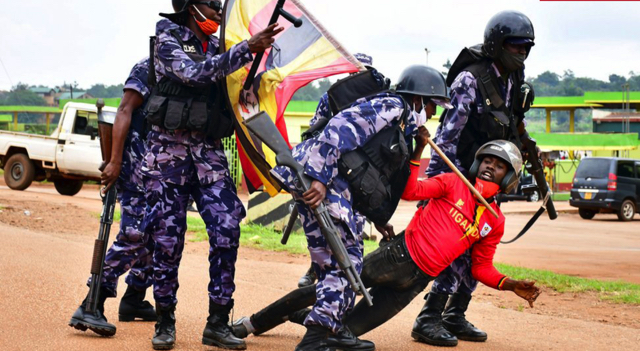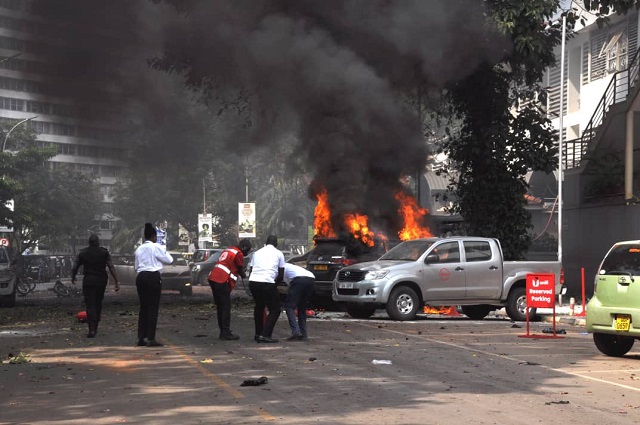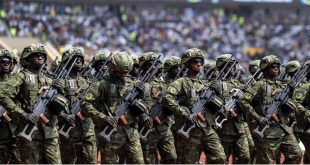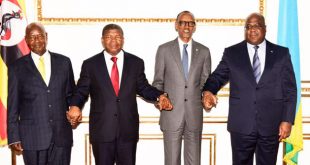
The facts and the controversy
Kampala, Uganda | THE INDEPENDENT | A fragile state is not a failed state. It is not one on the brink of conflict, collapse or failure. No. A fragile state is one that is vulnerable. A fragile a state is one that is vulnerable to conflict, collapse or failure.
So, is Uganda a fragile state?
According to a report by the Fund for Peace (FFP), an American non-governmental research and educational institution that works to prevent violent conflict and promote sustainable security, Uganda is a fragile state.
For over 60 years, the Fund for Peace (FFP) has been a world leader in developing practical tools and approaches for reducing conflict.
The report uses several indicators to get to this conclusion; including the extent to which the institutions and apparatus of the state are vulnerable or not to ensuring security of citizens, their economic prosperity, social well-being, education and health and more.
The report says factions among the elite, security threats, and an influx of huge numbers of refugees are among several pressures pushing the Uganda state towards the brink of failure.
To compile the report, the FFP apportions scores for every country based on twelve key political, social and economic indicators and over 100 sub-indicators that are the result of years of expert social science research.
These are grouped under four major indicators; cohesive (security apparatus, factionalised elite, group grievance), economic (Decline, uneven development. Human flight and brain drain), political (state legitimacy, public service, human rights and rule of law), and social and cross-cutting indicators (demographic pressure, refugees and IDPs, and external intervention).
Under the security category, the investigators consider many questions; especially on the relationship between Security and citizenry: Are the police considered to be professional? Is violence often state-sponsored and politically motivated? Is the government dealing well with any insurgency or security situation? Does the military and police maintain proper use of force? Are there accusations of police brutality?
The security threats to the state mentioned include bombings, attacks and battle-related deaths, rebel movements, mutinies, coups, or terrorism. Others are serious criminal factors, such as organised crime and homicides, and state-sponsored or state-supported private militias that terrorise political opponents, suspected “enemies,” or civilians seen to be sympathetic to the opposition. Also mentioned is a “deep state” that may consist of secret intelligence units or other irregular security forces that serve the interests of a political leader or clique. This indicator also takes into account armed resistance to the governing authority.
The `Factionalised Elites’ indicator measures power struggles, political competition, political transitions, and the credibility of electoral processes. Questions include: Is wealth concentrated in hands of a few? Is there a burgeoning middle class? Does any one group control the majority of resources? Are resources fairly distributed? Does the government adequately distribute wealth through taxes?
The factionalised elites describes fragmentation of state institutions along ethnic, class, clan, racial or religious lines, as well as brinksmanship and gridlock between ruling elites. It also factors in the use of nationalistic political rhetoric by ruling elites, often in terms of nationalism.
Under the economic indicators, questions revolve around Public Finances; what level is the government debt? And under economic conditions (interest rates, inflation rate, and unemployment) and Economic Climate (Consumer Confidence, Foreign Direct Investment, internal entrepreneurship) and Economic Diversification (Does one product make up the majority of the economy?).
Under state legitimacy there are questions about openness and fairness of the political process. Do all parties enjoy political rights? Is the government representative of the population? Have there been recent peaceful transitions of power? What is the longer term history of power transitions? Are elections perceived free and fair? Have elections been monitored and reported as free and fair?
Refugees flowing into Uganda are seen to be putting the pressure upon states caused by the forced their displacement as a result of social, political, environmental or other causes.
So, based on these indicators and your own assessment, is Uganda a fragile state or not?

The Fragile State Index
The highlight of the FFP report is the annual Fragile States Index (FSI) which ranks, in the authors’ analysis, how vulnerable or not a state is towards the brink of conflict, collapse or failure.
To compile the report, the FFP daily collects thousands of reports and information from around the world, detailing the existing social, economic and political pressures faced by each of the 179 countries that they analyse.
“The strength of the FSI is its ability to distill millions of pieces of information into a form that is relevant as well as easily digestible and informative,” the authors say.
In the FSI 2022 (which covers calendar year 2021), the five most fragile countries were Yemen, Somalia, Syria, South Sudan, and Central African Republic. With the exception of South Sudan, which was not an independent country until 2011, and Syria, these countries have been among the top 20 most fragile since the FSI started in 2005.
The Index has four tiers; sustainable, stable, warning, and alert. Each category has sub-categories. For example, Uganda is the worst category; the Alert. This category has the Alert, High Alert, and Very High Alert. These categories are coloured in four codes; blue, green, yellow, and red.
In the East African region, Uganda, Burundi and Ethiopia are in the Alert sub-category. This is the entry point into the `Red Zone’ of countries on the brink of vulnerability to collapse. For context and comparison, others in this sub-group are Burkina Faso, Zimbabwe, Libya, Nigeria, and more. There are 19 countries in this sub-category.
Deeper into the Red Zone, is the High Alert category with countries like DR Congo, Sudan, Central Africa Republic, and South Sudan. Others in this category are Afghanistan, Syria, Chad and more. There are eight countries in this sub-category.
The last and worst category; the Very High Alert, has only two countries: Somalia and Yemen as the worst and second worst in the world among fragile states.
By contrast, the most sustainable countries in the world are Finland, Norway, Iceland, New Zealand, Denmark, and Switzerland. They rank from number one to six or 179 to 174 on the Index.
The FSI scores should be interpreted with the understanding that the lower the score, the better.

Not failed states
The Fragile States Index is designed to be critical early warning tool. It is designed to highlight not only the normal pressures that all states experience, but also identify when those pressures are pushing a state towards the brink of failure.
The reasons for state fragility are complex but not unpredictable, say the authors of the FSI.
“Fault lines can emerge between identity groups, defined by language, religion, race, ethnicity, nationality, class, caste, clan or area of origin. Tensions can deteriorate into conflict through a variety of circumstances, such as competition over resources, predatory or fractured leadership, corruption, or unresolved group grievances,” they say.
According to them, it is critically important that the international community understand and closely monitor the conditions that contribute to fragility — and be prepared to take the necessary actions to deal with the underlying issues or otherwise mitigate the negative effects.
By highlighting pertinent issues in weak and failing states, The Fragile States Index—and the social science framework and software application upon which it is built—makes political risk assessment and early warning of conflict accessible to policy-makers and the public at large.
However, the FSI is not intended as a tool to predict when states may experience violence or collapse. Instead, one of the most critical aspects of the FSI is to show whether are country’s situation is improving or worsening.
The most worsened were countries in the 2022 report were Myanmar, Afghanistan, Burkina Faso, Haiti, and Lebanon. Myanmar had a coup. Afghanistan had a violent change of power. Burkina Faso had a rise in violent extremism. Haiti’s president was assassinated. Lebanon had a deepening economic and political crisis, and a rise in protest and violence.
The FSI does not measure direction or pace of change because it recognises that it is possible for a state sorted into the ‘stable’ zone to deteriorate at a faster rate than those in the more fragile ‘warning’ or ‘alert’ zones or for fragile “red zone” states to recover.
This partly explains why the authors dropped their earlier description of Red Zone countries as “failed states” to “Fragile states. Until 2014, the FSI was referred to as the Failed States Index. But controversy over the terminology contributed to change in name. Critics had argued that the term established a false binary division, or false dichotomy, between states that were salvageable and those that were beyond recovery.
The producers of the Index responded with a disclaimer that, “The FSI is not a forecasting tool”.
“The rankings have little to say about the probability of protest or regime change at any particular point in time,” said Nate Haken, the Vice President for Research and Innovation at FFP who leads the development of the Conflict Assessment System Tool (CAST) used to create the Fragile States Index.
That could possibly explain why Uganda’s ranking on the Fragile States Index in 2022 is the best since 2006. According to the almost two decade-long analysis, Uganda remains a fragile state but its structure and institutions have never been more solid or its invulnerability more pronounced.
Compared to last year, for example, Uganda had a total score of 92.9 compared to 92.1 this year. Once again, the FSI scores should be interpreted with the understanding that the lower the score, the better.
There are analysts, however, who might disagree with such a positive outlook. They might point at signs of political instability such as the frequent abductions and torture of opposition supporters, especially from the National Unity Platform (NUP) party of Robert Kyagulanyi, and recently of the National Economic Empowerment Dialogue (NEED) party leader, Joseph Kabuleta. They might point at the economic uncertainty, high inflation, and declining public social service sector and corruption. They might point at the transition politics within the ruling NRM party that involve President Yoweri Museveni who has been in power for 36 years and his son, Gen. Muhoozi Kainerugaba who aspires to succeed him.
This camp might insist on tracking how closely each indicator on the FSI is associated with state failure. This has been an ongoing debate with some analysts claiming that some indicators on the FSI measures are more correlated to state failure than others.
An essay published by the Wilson Centre, an American policy forum that researches global issues to inform members of Congress, argues that taken at face value, one could argue that the FSI numbers seem to favor a realist outlook on why states fail.
“Strength of the security apparatus and legitimacy of the government are consistently the highest factors in countries’ overall scores. But demographic pressures, disregard for human rights, and declining public services also follow close behind,” it says.
A look at these indicators for Uganda, appears to back this conclusion.
For security Apparatus, Uganda was scored 6.9 in 2021 compared to 8.9 this year. That means the Uganda state is more vulnerable to failure on that score today than last year. On Legitimacy of government, Uganda scored 8.9 last compared to 9.2 this year. That means the Uganda state is more vulnerable to failure on legitimacy today than last year. It also appears that more people are leaving the country today than last year, the public service is worse, and group grievances against the state are growing.
But Uganda scores favourably on the economic indicators and some social and cross-cutting indicators such as external intervention which considers the influence and impact of external actors in the functioning – particularly security and economic – of the state, and on demographic pressures indicator which considers pressures upon the state deriving from the population itself or the environment around it. These might appear to be of limited impact on the vulnerability of the state compared to the cohesion, economic and political indicators. But they matter.
Context matters
One of the sub-titles of the 2022 FSI is ‘Coming apart at the seams: Fragility in a time of covid-19’.
“The last two years have challenged many assumptions about what it means to be fragile and what it means to be resilient. Countries that were thought to be strong proved weak,” says Nate Haken. He points out that, because of the 2020 outbreak of COVID-19, by 2021, “Factors measured in the Fragile States Index (FSI), such as social and political cohesion, had as much, or more impact on resilience than access to quality health services”.
He adds: “Previously, state fragility was seen as something to be contained and mitigated in the developing world so that it does not spread to the rich countries. Now, however, we are discovering that fragility can flow both ways. War in Europe can lead to food crises in Africa. A pandemic can just as easily spread from North to South”.
The report says the year 2020 also had the worst recorded global GDP contraction in over 60 years, and although the global economy rebounded robustly in 2021, there was a record number of people (an increase of over 20 million) internally displaced by violence and natural disasters including in places like Afghanistan, the DR Congo, Ethiopia, and Myanmar. Whether Uganda is a fragile state or not should be understood in that context.
****
 The Independent Uganda: You get the Truth we Pay the Price
The Independent Uganda: You get the Truth we Pay the Price


